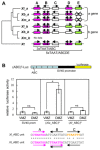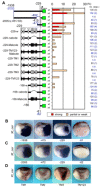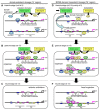Dynamic in vivo binding of transcription factors to cis-regulatory modules of cer and gsc in the stepwise formation of the Spemann-Mangold organizer
- PMID: 22492356
- PMCID: PMC4074222
- DOI: 10.1242/dev.068395
Dynamic in vivo binding of transcription factors to cis-regulatory modules of cer and gsc in the stepwise formation of the Spemann-Mangold organizer
Abstract
How multiple developmental cues are integrated on cis-regulatory modules (CRMs) for cell fate decisions remains uncertain. The Spemann-Mangold organizer in Xenopus embryos expresses the transcription factors Lim1/Lhx1, Otx2, Mix1, Siamois (Sia) and VegT. Reporter analyses using sperm nuclear transplantation and DNA injection showed that cerberus (cer) and goosecoid (gsc) are activated by the aforementioned transcription factors through CRMs conserved between X. laevis and X. tropicalis. ChIP-qPCR analysis for the five transcription factors revealed that cer and gsc CRMs are initially bound by both Sia and VegT at the late blastula stage, and subsequently bound by all five factors at the gastrula stage. At the neurula stage, only binding of Lim1 and Otx2 to the gsc CRM, among others, persists, which corresponds to their co-expression in the prechordal plate. Based on these data, together with detailed expression pattern analysis, we propose a new model of stepwise formation of the organizer, in which (1) maternal VegT and Wnt-induced Sia first bind to CRMs at the blastula stage; then (2) Nodal-inducible Lim1, Otx2, Mix1 and zygotic VegT are bound to CRMs in the dorsal endodermal and mesodermal regions where all these genes are co-expressed; and (3) these two regions are combined at the gastrula stage to form the organizer. Thus, the in vivo dynamics of multiple transcription factors highlight their roles in the initiation and maintenance of gene expression, and also reveal the stepwise integration of maternal, Nodal and Wnt signaling on CRMs of organizer genes to generate the organizer.
Figures






Similar articles
-
Evolution of cis-regulatory modules for the head organizer gene goosecoid in chordates: comparisons between Branchiostoma and Xenopus.Zoological Lett. 2019 Aug 2;5:27. doi: 10.1186/s40851-019-0143-1. eCollection 2019. Zoological Lett. 2019. PMID: 31388442 Free PMC article.
-
Siamois and Twin are redundant and essential in formation of the Spemann organizer.Dev Biol. 2011 Apr 15;352(2):367-81. doi: 10.1016/j.ydbio.2011.01.034. Epub 2011 Feb 3. Dev Biol. 2011. PMID: 21295564 Free PMC article.
-
Transcriptional integration of Wnt and Nodal pathways in establishment of the Spemann organizer.Dev Biol. 2012 Aug 15;368(2):231-41. doi: 10.1016/j.ydbio.2012.05.018. Epub 2012 May 22. Dev Biol. 2012. PMID: 22627292 Free PMC article.
-
Molecular mechanisms of cell-cell signaling by the Spemann-Mangold organizer.Int J Dev Biol. 2001;45(1):189-97. Int J Dev Biol. 2001. PMID: 11291846 Free PMC article. Review.
-
The Spemann-Mangold organizer: the control of fate specification and morphogenetic rearrangements during gastrulation in Xenopus.Int J Dev Biol. 2001;45(1):251-8. Int J Dev Biol. 2001. PMID: 11291854 Review.
Cited by
-
Early neural ectodermal genes are activated by Siamois and Twin during blastula stages.Genesis. 2015 May;53(5):308-20. doi: 10.1002/dvg.22854. Epub 2015 May 5. Genesis. 2015. PMID: 25892704 Free PMC article.
-
Endodermal Maternal Transcription Factors Establish Super-Enhancers during Zygotic Genome Activation.Cell Rep. 2019 Jun 4;27(10):2962-2977.e5. doi: 10.1016/j.celrep.2019.05.013. Cell Rep. 2019. PMID: 31167141 Free PMC article.
-
Small C-terminal Domain Phosphatase 3 Dephosphorylates the Linker Sites of Receptor-regulated Smads (R-Smads) to Ensure Transforming Growth Factor β (TGFβ)-mediated Germ Layer Induction in Xenopus Embryos.J Biol Chem. 2015 Jul 10;290(28):17239-49. doi: 10.1074/jbc.M115.655605. Epub 2015 May 26. J Biol Chem. 2015. PMID: 26013826 Free PMC article.
-
The Organizer and Its Signaling in Embryonic Development.J Dev Biol. 2021 Nov 1;9(4):47. doi: 10.3390/jdb9040047. J Dev Biol. 2021. PMID: 34842722 Free PMC article. Review.
-
Evolution of cis-regulatory modules for the head organizer gene goosecoid in chordates: comparisons between Branchiostoma and Xenopus.Zoological Lett. 2019 Aug 2;5:27. doi: 10.1186/s40851-019-0143-1. eCollection 2019. Zoological Lett. 2019. PMID: 31388442 Free PMC article.
References
-
- Bauer D. V., Huang S., Moody S. A. (1994). The cleavage stage origin of Spemann’s Organizer: analysis of the movements of blastomere clones before and during gastrulation in Xenopus. Development 120, 1179–1189 - PubMed
-
- Blitz I. L., Cho K. W. (1995). Anterior neurectoderm is progressively induced during gastrulation: the role of the Xenopus homeobox gene orthodenticle. Development 121, 993–1004 - PubMed
-
- Bouwmeester T., Kim S., Sasai Y., Lu B., De Robertis E. M. (1996). Cerberus is a head-inducing secreted factor expressed in the anterior endoderm of Spemann’s organizer. Nature 382, 595–601 - PubMed
Publication types
MeSH terms
Substances
LinkOut - more resources
Full Text Sources
Research Materials

